#CANINE HEALTH
Explore tagged Tumblr posts
Text
It's possible I'm just not on here enough to see people talking about this but I have yet to see any posts going around mentioning the new canine respiratory virus that's making the rounds in the United States. Here's a non-paywalled news article on the virus.
Symptoms include tiredness, fever, eating less, a wet cough, a runny nose and/or runny eyes, difficulty breathing, and pneumonia.
Steps to take to protect your dogs include making sure they're up to date on all their vaccines and practicing doggy social distancing. Avoid play groups, group training classes, kennels, daycares, any other situations where your dogs are in close contact with lots of other dogs, and definitely letting your dogs drink from the same water bowls as other random dogs.
316 notes
·
View notes
Text
Gastric carcinoma is a type of cancer with a strong breed predisposition in the Tervueren and Groenendael long-haired varieties of the Belgian Shepherd dog. We conducted a study of the incidence of gastric carcinoma in Tervueren and Groenendael dogs that were born in the Netherlands between 2000 and 2010.
We found that on average during this period 3.8% of long-haired Belgian Shepherds develop gastric carcinoma during their lifetime. For the Tervueren variety the percentage of reported dogs that developed gastric carcinoma during their lifetime was 4.7% and for the Groenendael 2.1%. No sex predilection was demonstrated. The median age at death from gastric carcinoma in these dogs was 9.0 years.
The heritability was calculated to be 0.53, indicating a strong hereditary component to development of the disease. The odds of developing gastric carcinoma in offspring are higher if at least one parent is affected compared to if parents are not known to be affected. Effective selection against this disease in this dog population is challenging, as dogs are often diagnosed with this disease after they have been used for breeding.
#canine health#gastric cancer#belgian tervuren#belgian groenendael#yesterday everyone was discussing how to select against it#crossing into working mals was suggested#which of course means that showlines would start needing to test for sdca#but at least that has a test#gastric cancer does not#breeding is hard
14 notes
·
View notes
Text
5 Tips to Keep Your Dog Warm in the Winter
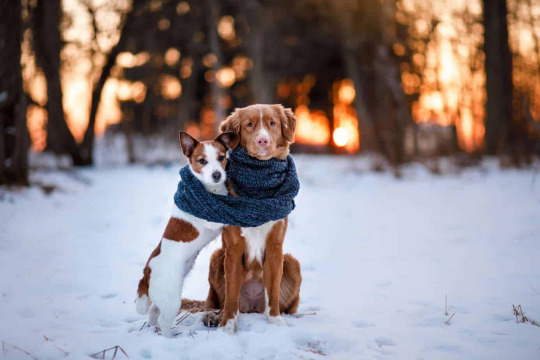
Invest in doggy outerwear - sweaters, hoodies, jackets, vests, even shoes! There's a whole market of pet clothing nowadays. One of our favorite brands of K9 outerwear is Canada Pooch

It's important to note that not every dog's coat may be enough to keep them warm in the winter - especially puppies, small or hairless breeds, elderly dogs, or those with health issues. Just like with people, pets' cold tolerance can vary based on their coat, body fat stores, activity level, and health. Pets with heart disease, kidney disease, or metabolic diseases like diabetes and Cushing's might also have a harder time regulating their body temperatures.
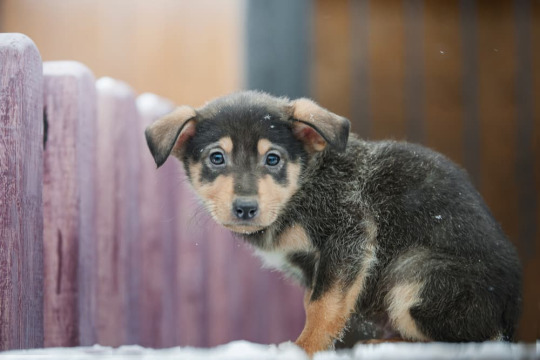
Protect your dog's paws when it's snowing. Boots can help minimize contact with the ground and prevent snow and ice from getting lodged between their toes and causing frostbite. Like chapped lips, cracked paws can be annoying and painful, and built up snow and ice can irritate their sensitive skin between their toes.
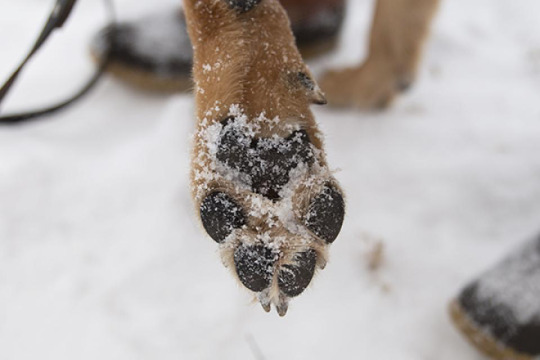
It might feel awkward at first for some dogs, so try to use positive reinforcement as they try to adjust to wearing their boots. Offer high-reward treats so they can learn to associate good things with their boots - when the boots are on, good things are going to happen! :)
youtube
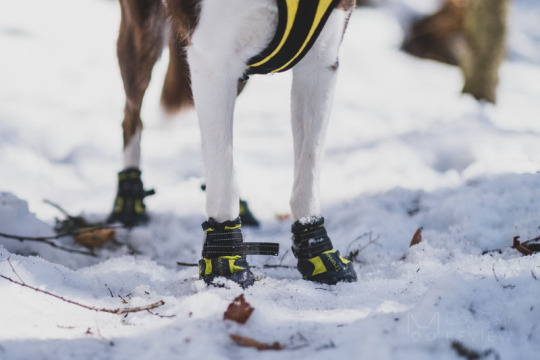
If boots still don't feel right for your dog, you can try applying paw balm or petroleum jelly-based products like Musher's Secret to keep your dog's paws safe and moisturized.

Just always be sure to wipe down and clean your dog's paws thoroughly with with a warm cloth when they come back inside. Sometimes salt and anti-freeze are put on sidewalks and driveways, which can cause chemical burns on your pet's paw pads or gastrointestinal issues if they try to lick it off.
Limit their time outdoors. Winter walks aren't always so magical. Know your dog's limits and shorten their walks if needed. If you can, reserve walks for the warmest parts of the day.
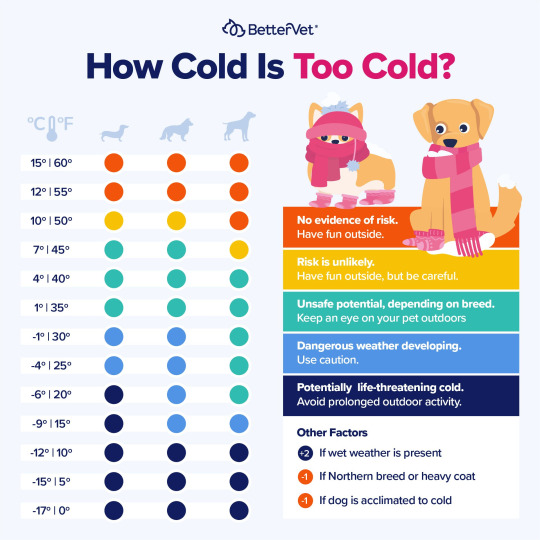
Signs to tell if your dog is too cold: - Shaking, shivering, or trembling - Hunched posture with tail-tucking - Slowing down or reluctant to walk/move - Lifting their paws off the ground - Whining or barking - Ears and nose feel very cold to the touch Even if you decide to leave your dog in the car while you run an errand, it can still be dangerous if they are left for too long without any heat support when its below 30 degrees F outside. While cars can trap blazing temperatures in the summer and open risk for heatstroke, they can also trap freezing temperatures in the winter and open risk for hypothermia. Perhaps try to sit in your car without a jacket and see how long you can bare waiting in there without the heater on.
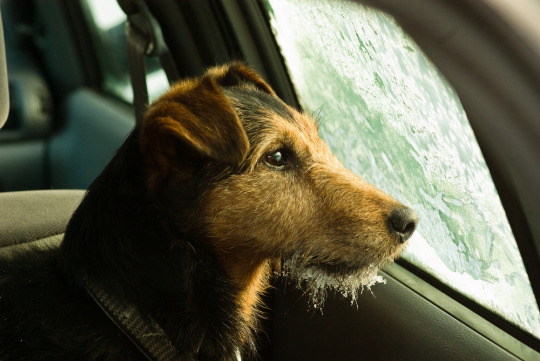
Provide choices! Give your dog more options for comfortable sleeping places with varying levels of bedding and blankets, in case they need to change their location for more or less warmth.

Set up cozy, wet-proof areas outdoors with heating lamps and wind barriers. Make sure kennels and igloos/houses are well-insulated and have enough space for them to walk in, turn around, and comfortably lay in.
youtube
Unless you have a healthy conditioned sled dog, I would not recommend letting them spend the night outdoors in the snow, without proper shelter and heat support. Watch how cold it can get in a simple dog house:
youtube
Serve warm food and water. At minimum, aim to make sure whatever they consume is at room temperature - but preferably just above their body temperature (101-103 F) when it's especially cold. Warming their food will also bring out their aroma and make it more enticing for them to eat. If feeding kibble/dry or dehydrated, you can mix in some warm bone broth. If it's canned/wet food, avoid microwaving for too long, as this can make the food too hot and potentially deplete its nutrients. Instead, try warming up your dog's wet food with this technique:
As for home-cooked/fresh food, the Balance It Canine Plus supplement not only makes your dog's complete and balanced, but is actually formulated to withstand reheating/microwaving. Our personal favorite! Below is a tutorial on how to utilize the Balance It system:
youtube
When selecting ingredients for your dog's food in the winter, consider including "warming" foods according to TCVM food energetics. Examples of these would be meats like lamb, goat, or venison, and vegetables and starches like sweet potatoes and oats. Traditional Chinese medicine teaches that hot/warm food nourishes the body by bringing heat which improves circulation. To support this theory, some studies have found that food associated with heat consists of compounds that are on average lower in molecular weight, yet higher in protein and fat - which contribute to energy production, and magnesium and potassium - which contribute to blood pressure and nerve function.(https://www.sciencedirect.com/science/article/pii/S2666154320300247) Here is a list of some hot/warm commercial pet food and treats: - SideBySide Pet "Warming" - Dr. Judy Morgan's Fire Element Diet - Pet Tao "Blaze" Freeze Dried Raw Formula - JustFoodForDogs Venison & Squash Recipe - JustFoodForDogs Lamb & Rice Recipe
For more information on food energetics, watch this video:
youtube
5 notes
·
View notes
Link
Is your pet struggling to reach their favorite spots? Say hello to dog stairs! Whether you have a small pup, an elderly pooch, or a pet with mobility issues, the right set of stairs can transform their life. Our latest roundup features the top-rated dog stairs that not only boost comfort but also keep your furry friend safe while climbing onto beds, couches, and even into cars.
From sturdy multi-tier options to soft foam ramps designed for senior pets, there’s something for every size and need. Plus, many come with added features like storage and non-slip surfaces for peace of mind. Spoiling your pet while promoting their independence has never been easier! Check out these picks to find the perfect fit for your furball.
#dog stairs#pet stairs#dog mobility#pet products#elderly dogs#dog ramp#pet care#pet safety#dog accessories#pet comfort#senior pets#pet independence#dog owners#canine health#dog beds#pet gifts#dog lovers#dog supplies#home decor for pets#small dog stairs#non-slip stairs#pet-friendly furniture#dog lifestyle
0 notes
Text



0 notes
Text
Are Bully Sticks Safe for Dogs in 2024? Shocking Truth!
Are Bully Sticks Safe for Dogs? As a responsible pet owner, you’re likely always on the lookout for safe, engaging treats for your canine companion. Bully sticks have gained popularity in recent years, but you may wonder about their safety and nutritional value. These natural chews, made from bull pizzle, offer several benefits for dogs, including dental health and mental stimulation. However,…
#Are bully sticks safe for dogs#Bacterial contamination in dog treats#Benefits of bully sticks#Bully stick calorie content#Bully stick risks#Bully sticks safety#canine health#Choosing bully sticks for dogs#Dental health for dogs#digestive issues in dogs#Dog chew treats#dog nutrition#Dog treat guidelines#dog treats#High-quality bully sticks#Nutritional value of bully sticks
0 notes
Link
🐶✨ Discover the secret to keeping your dog’s joints healthy and pain-free! In my latest article, I reveal the best dog joint supplement that has truly transformed Max and Bella’s lives. 🐕💪 Say goodbye to joint discomfort and hello to playful, happy pups! Click the link to find out which supplement made all the difference. 🌟
#joint health#dog health#dog care#pet care#pet health#healthy dogs#healthy pets#happy dog#pet supplements#dog supplements#dog lover#puppy love#canine health#pet wellness
0 notes
Text
Can Dogs Have Salmon? Full Guide for Dog Owners
Wondering if salmon is safe for your dog? This comprehensive guide covers everything you need to know about feeding salmon to dogs, from its nutritional benefits to cooking tips and potential risks. Learn how to safely incorporate this nutritious fish into your dog’s diet and discover the many health benefits it offers.
#Dogs#Dog Nutrition#Salmon for Dogs#Dog Diet#Canine Health#Omega-3 for Dogs#Dog Owners#Dog Lovers#Pet Care#Dog Treats
0 notes
Text
People tell me my pets are skinny all the time, and keep in mind, my dogs come with me to work... In the clinic... My dogs are both easily 5/9 BCS dogs, with my Terrier being a 3/5 MCS (average pet muscling), and my Malinois being a 4-5/5 MCS (basically the maximum muscling you can achieve in a dog)
While I don't think everyone should maintain their dogs the way my mal looks, they absolutely should be maintaining the way my terrier looks, he is lean, healthy, and decently muscled.
I work in rehabilitation, and I see a LOT of CCL tears and Spinal discomfort, while Genetics and conformation play a big role in that, the biggest factor that you as an owner have? Is keeping them at an appropriate weight. I've had one patient who did a full CCL tear while at a healthy weight, and that dog also didn't do a partial tear or full tear on the opposite leg as we worked on healing the first one. She was also a performance dog who had this tear occur halfway through an agility course. Meanwhile, I almost exclusively see full tears when patients are above a 7/9 BCS and they're almost always accompanied by a partial tear or full tear in the opposite leg within 6 months.
Their recovery takes significantly longer, their prognosis is worse, and they often have even more issues come up in their spines, shoulders, and elbows during recovery because they have too much weight to effectively support on 4 legs, let alone 3 or 2 legs, resulting in secondary and tertiary injuries.
Obese pets aren't cute, and obese pets have worse health outcomes. Talk to your vet about your pet's BCS score and, if your vet evaluates it, MCS (Muscle Condition Score) and honestly discuss what the pet is eating, including toppers, treats, supplements, and actual volume of food. Also, you can use this calculator to calculate how much of your food you should be feeding as a baseline (not just trusting the bag amounts)
Pets are very commonly overweight. And very commonly the reason given will be ‘because my parents feed them more than they’re supposed to, and they won’t listen when I tell them to stop’.
And I sympathise. I understand. Parents are hard, especially when they still think of you as ‘their kid’ and not ‘grown adult with autonomy’. Getting your parent to change their behavior is very difficult.
My two cats have a scoop in their bag of food, and they get one scoop each for dinner. It’s a very simple system: 1 scoop 1 cat. If I notice they’re getting a bit podgy then I make the scoop a bit concave. If they’re looking a bit light, I give them a little extra breakfast. But dinner is always the same, never more than one scoop.
But last night I watch my mother (the very same woman that scolded me for my weight since I was ten) decide to feed the cats for me while I finished washing the dishes.
The cats follow her, mewing pathetically, as she carries the food bag to their bowls. And I watch, as she’s talking to me and making eye contact, while she gives one cat a slightly heaped scoop of food, and then the other.
And then, dear reader, she replaces the scoop into the bag, as though it’s the most natural thing in the world, and proceeds to give each cat an additional handful of food.
I was astounded. I was politely mortified that you just increased the cats’ meals by at least 80%. No wonder they’ve been podgy!
We had a polite but firm discussion about how that is a measured scoop in the bag, and have-you-been-feeding-that-much-the-whole-time, but I do not think she has listened. I think I will need to gently ban her from feeding the cats.
#vet studyblr#vet med#Veterinary Medicine#CVT2DVM#Obesity in Companion Animals#Pet Obesity#Obesity#Rehabilitation & Sports Medicine - Veterinary#Veterinary Sports Medicine#Veterinary Rehabilitation#Dogs#Canine Health#Feline Health#Companion Animal Health#Companion Animal Medicine#PreVet#Veterinary Rehabilitation Medicine#Vet Rehab
2K notes
·
View notes
Text
Understanding Kennel Cough: Causes, Symptoms, and Treatment Options
Introduction
Kennel Cough, a highly contagious respiratory infection, is something every dog owner should be aware of. While the name might sound specific to kennels, the reality is that it can affect any dog, anywhere. Understanding Kennel Cough in dogs, including its causes, symptoms, and treatment options, can help you keep your furry friend healthy and happy. At Cascade Summit Animal Hospital, we are committed to providing the best care and information to keep your pets safe.

Causes of Canine Kennel Cough
Canine Kennel Cough is a complex condition with multiple potential causes, often involving both bacterial and viral agents.
Bacterial Causes
The most common bacterial culprit is Bordetella bronchiseptica. This bacterium can weaken the immune system, making dogs more susceptible to other infections.
Viral Causes
Canine Parainfluenza Virus: One of the primary viruses that contribute to Kennel Cough, this virus attacks the respiratory system, making it easier for bacteria to take hold.
Canine Adenovirus: This virus can also cause respiratory issues, leading to Kennel Cough.
Environmental Factors
Stress: Just like humans, dogs under stress are more likely to get sick. Changes in environment or routine can be significant stressors.
Poor Ventilation: Dogs in poorly ventilated areas are at a higher risk of contracting Kennel Cough, as airborne pathogens can accumulate more easily.
Symptoms of Kennel Cough
Recognizing the symptoms of Kennel Cough early can help in managing the condition effectively.
Common Symptoms
Persistent Cough: A loud, honking cough is the hallmark symptom of Kennel Cough.
Gagging or Retching: Dogs may make sounds similar to gagging, especially after coughing fits.
Severe Symptoms
Fever: Elevated body temperature can indicate a more severe infection.
Lethargy: A noticeable decrease in activity levels.
Loss of Appetite: Dogs may eat less or refuse food altogether.
Diagnosis of Kennel Cough
Getting a proper diagnosis from a veterinarian is crucial.
Veterinary Examination
Physical Exam: The vet will listen to your dog’s lungs and heart and check for other signs of illness.
Medical History: Understanding your dog’s recent activities and exposure to other dogs can help pinpoint the cause.
Diagnostic Tests
X-rays: These can help rule out other respiratory conditions.
Blood Tests: These tests can identify underlying infections or other health issues.
Treatment Options for Kennel Cough
Once diagnosed, there are several treatment options available.
Medical Treatments
Antibiotics: These are often prescribed if a bacterial infection is present.
Cough Suppressants: To help manage the persistent coughing.
Home Remedies
Humidifiers: Using a humidifier can soothe your dog’s irritated throat and airways.
Hydration: Ensuring your dog drinks plenty of water is essential for recovery.
Prevention Methods
Vaccination: Regular vaccinations can significantly reduce the risk of Kennel Cough.
Reducing Exposure: Avoiding crowded dog areas during an outbreak can prevent your dog from contracting the illness.
Kennel Cough in Dogs
Understanding the broader context of Kennel Cough can help in managing and preventing it.
Risk Factors
Age and Immune System: Puppies and older dogs are more susceptible due to weaker immune systems.
Living Conditions: Dogs in crowded or poorly ventilated spaces are at a higher risk.
Kennel Cough Outbreaks
How Outbreaks Occur: Outbreaks typically happen in places where many dogs congregate, like kennels and dog parks.
Managing an Outbreak: Isolating infected dogs and thorough cleaning can help control an outbreak.
Myths and Misconceptions About Kennel Cough
There are several myths surrounding Kennel Cough that need to be debunked.
Common Myths
Only Affects Dogs in Kennels: This is not true. Any dog, even those that never visit kennels, can contract Kennel Cough.
It Is Always Severe: Many cases are mild and resolve on their own with proper care.
The Truth
Wide Range of Environments: Dogs can catch Kennel Cough in various settings, not just kennels.
Varies in Severity: Symptoms can range from mild to severe, depending on the individual dog and the strain of the pathogen.
When to See a Veterinarian
Knowing when to seek professional help is crucial for your dog’s health.
Persistent Symptoms
When the Cough Doesn’t Improve: If your dog’s cough persists for more than a week, it’s time to see a vet.
Emergency Symptoms
Difficulty Breathing: This is a sign of a severe infection and needs immediate attention.
High Fever: A high fever can indicate a secondary infection that requires treatment.
Conclusion
Kennel Cough is a common but manageable condition. Understanding the causes, symptoms, and treatment options can help you protect your dog and ensure a speedy recovery if they do get sick. Early intervention and regular veterinary care are key to keeping your furry friend healthy. At Cascade Summit Animal Hospital, we’re here to support you and your pet through any health challenges.
#Kennel Cough#Kennel Cough in Dogs#Dog Respiratory Infection#Canine Health#Pet Care#Cascade Summit Animal Hospital#Dog Health Tips#Pet Wellness#Kennel Cough Symptoms#Dog Treatment Option
0 notes
Text
Understanding CCL Tears in Dogs: Causes and Symptoms
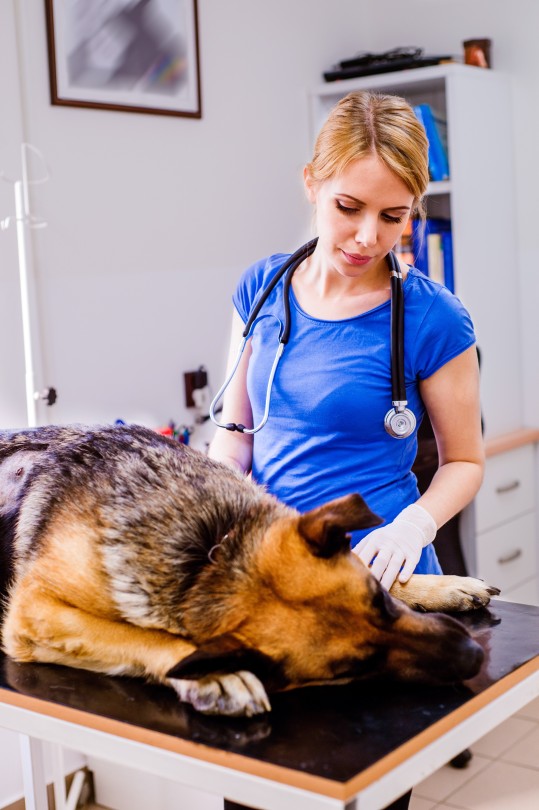
CCL (cranial cruciate ligament) tears are a common orthopedic injury affecting dogs, particularly those who are active or overweight. This article delves into the causes, symptoms, and implications of CCL tears in canines, providing valuable insights for pet owners.
What is the CCL? The cranial cruciate ligament (CCL) plays a crucial role in stabilizing the knee joint (stifle) of dogs. Located within the knee, the CCL connects the femur (thigh bone) to the tibia (shin bone), facilitating smooth movement and preventing excessive forward movement of the tibia relative to the femur.
Causes of CCL Tears in Dogs CCL tears can occur due to various factors, including:
Trauma: Sudden twists, falls, or collisions can overstress the ligament, leading to tears. Chronic Degeneration: Long-term wear and tear on the ligament can weaken it over time, making it prone to tearing with minimal force. Genetic Predisposition: Certain breeds are more susceptible to CCL tears, such as Labrador Retrievers, Golden Retrievers, and Rottweilers. Obesity: Excess weight places additional strain on the ligament, increasing the risk of injury. Anatomy: The angle of a dog's knee joint can influence the likelihood of CCL tears. Symptoms of CCL Tears in Dogs Recognizing the signs of a CCL tear early can lead to prompt treatment and better outcomes. Common symptoms include:
Lameness: Sudden or progressive limping, favoring one leg over the other. Swelling: Visible swelling around the knee joint. Difficulty Rising: Reluctance or difficulty getting up from a sitting or lying position. Stiffness: Noticeable stiffness, especially after rest or exercise. Decreased Activity: Reluctance to engage in physical activities that were previously enjoyed. Diagnosing CCL Tears When suspecting a CCL tear, veterinarians typically perform a thorough physical examination, assessing the dog's gait, range of motion, and joint stability. Diagnostic tools such as X-rays or advanced imaging techniques like MRI may be used to confirm the diagnosis and evaluate the severity of the injury.
Treatment Options for CCL Tears Treatment options for CCL tears in dogs depend on the severity of the injury, the dog's age, size, and activity level. Common approaches include:
Surgical Intervention: Surgical procedures like TPLO (Tibial Plateau Leveling Osteotomy), TTA (Tibial Tuberosity Advancement), or extracapsular repair aim to stabilize the knee joint and promote healing. Conservative Management: In less severe cases or for dogs who are poor candidates for surgery, conservative management may involve rest, physical therapy, weight management, and anti-inflammatory medications to alleviate pain and support healing. Prognosis and Rehabilitation The prognosis for dogs with CCL tears varies depending on the chosen treatment method and the individual dog's response to therapy. Surgical intervention often provides the most predictable outcomes, with many dogs returning to near-normal function with proper rehabilitation. Physical therapy, including exercises to strengthen the muscles surrounding the knee joint, is crucial in aiding recovery and preventing future injuries.
Preventing CCL Tears in Dogs While some risk factors like breed predisposition cannot be controlled, steps can be taken to reduce the likelihood of CCL tears in dogs. Maintaining a healthy weight through proper diet and regular exercise helps minimize stress on the joints. Additionally, avoiding high-impact activities and ensuring gradual conditioning for athletic dogs can lower the risk of injury.
Conclusion In conclusion, understanding the causes, symptoms, and treatment options for CCL tears in dogs is essential for pet owners to recognize signs early and seek timely veterinary care. By addressing CCL injuries promptly and effectively, pet owners can improve their dog's quality of life and promote long-term joint health.
By incorporating these insights, pet owners can better understand and manage CCL tears in their beloved canine companions, ensuring they receive the care and attention needed for optimal recovery and future joint health.
1 note
·
View note
Text

✦ Come hell or high water ✦
#own art#own characters#CanisAlbus#art#artists on tumblr#Vasco#Machete#anthro#scenthound#sighthound#dogs#canine#animals#Vasco's worries and insecurities creep out at night when his sunny and optimistic shield is at it's thinnest#when did their situation become so dire? what could have they done differently?#how powerless he feels when facing Machete's ailing health and the snare that keeps tightening around his neck at work#every time he visits him there's less of him left#how much would he be prepared to risk to keep them both safe if it came to that#and would they succeed if they somehow tried to make a break for it and leave everything behind
5K notes
·
View notes
Text
LEPTOSPIROSIS IN DOGS
Leptospirosis is a zoonotic disease caused by the infection of bacteria belonging to the genus Leptospira. It is most commonly transmitted through mucous membrane contact or wound exposure to urine of infected mammals, or contaminated food, bedding, soil, or water.



Leptospira like to live in warm, wet environments like damp soil/grass, mud, standing water, and lakes or ponds. Under ideal conditions, the bacteria can survive more than three months outside the body. Rodents and domesticated animals including raccoons, skunks, opossums, rats, cows, and pigs are but a few of the many known carriers. Because of the broad range of carrier species, any dog - even one that is briefly outdoors - may be vulnerable to the disease.




Each year, more than a million cases of leptospirosis are reported worldwide, with an estimated 59,000 deaths. Leptospirosis continues to be prevalent in dogs, although symptoms may vary depending on the strain of Leptospira bacteria and the dog’s immune system. While some infected dogs may show little to no signs of illness and recover on their own, others may develop severe, life-threatening illness. Most common signs include:
Lethargy
Loss of appetite
Vomiting/diarrhea
Abdominal pain
Jaundice (yellowing of the skin or mucous membranes)
Dehydration
Increased thirst and urination
Weight loss
Stiffness or muscle pain
The disease may progress into acute kidney and/or liver failure. Some dogs may even develop lung disease and rapid, difficulty breathing, damage to the heart muscles, or bleeding disorders that may exhibit through blood-tinged vomit, feces, or urine, nose bleeds, or petechia (red spots or bruising on the gums and other light-skinned areas). Fluid may also build up in the body, causing swollen limbs or excess fluid in the chest or abdomen.


Because leptospirosis may appear like many other illnesses, it is important to share information about your dog’s lifestyle and travel history that may highlight possible exposure to Leptospira bacteria. While there are various leptospirosis testing available, micro-agglutination tests (MAT) are the gold standard, and additional diagnostics including bloodwork, urinalysis, and ultrasound may also be recommended.


Leptospirosis is generally treated with antibiotics and supportive care. Patients are often hospitalized to receive fluid therapy, IV medications, nutritional support, and sometimes oxygen therapy and/or plasma transfusions in more severe cases.

Fortunately, there are vaccines available that protect against this life-threatening disease. Vaccinating dogs for leptospirosis may help protect their owners from infection, too. Aside from that, other precautions should be made to reduce risk of exposure:
Avoid letting your dog swim or drink from lakes, rivers, ponds, or any slow-moving or stagnant waters, puddles, or public/shared water bowls

Keep your dog away from farm animals and rodents, including carcasses, and minimize free-roaming in rural or peri-urban areas


Protect your dog’s paws with booties if they have any open wounds or sores

WARNING: If your dog is diagnosed with, or suspected to have leptospirosis, it is important to note that any animals that are not treated completely may shed Leptospira bacteria in their urine for up to three months. Promptly clean and disinfect any urine or contaminated areas within the home, and wear gloves while doing so. Also be mindful in guiding your dog to urinate far away from any areas other people or animals may have access to.


SOURCES/FURTHER READING
“Leptospirosis in Animals.” CDC, U.S. Centers for Disease Control and Prevention, 29 Apr. 2024, www.cdc.gov/leptospirosis/pets/index.html.
“Leptospirosis in Dogs.” AVMA Resources for Pet Owners, American Veterinary Medical Association, www.avma.org/resources-tools/pet-owners/petcare/leptospirosis.
Lunn, Katharine F. “Leptospirosis in Animals - Overview.” Merck Veterinary Manual, Merck & Co., Inc., Feb. 2022, www.merckvetmanual.com/generalized-conditions/leptospirosis/leptospirosis-in-animals-overview.
Sykes, Jane E., et al. “Updated ACVIM consensus statement on leptospirosis in dogs.” Journal of Veterinary Internal Medicine, vol. 37, no. 6, 20 Oct. 2023, pp. 1966–1982, https://doi.org/10.1111/jvim.16903.
Sykes, Jane E., and Krystle L. Reagan. “Leptospirosis in Dogs: Diagnosis, Treatment, and Management .” Today’s Veterinary Practice, no. Sept/Oct 2019, 9 Aug. 2019, https://todaysveterinarypractice.com/infectious-disease/diagnosis-and-treatment-of-leptospirosis-in-dogs/.
1 note
·
View note
Text
The Omega-3 Debate: Which Fish Oil Wins for Dog Health?
Maximise your dog's health with the ultimate fish oil guide! 🐕💧 Discover which fish oil provides the best omega-3 benefits for joint support, brain health, and a lustrous coat. Start enhancing your furry friend's diet today! 🐟 #FishOilForDogs #Omega3
When it comes to our four-legged friends, we’re constantly on the lookout for ways to enhance their health and longevity. Among the myriad of supplements vying for attention, fish oil stands out, particularly for its omega-3 fatty acids. But with the ocean teeming with different types of fish, each promising to be the elixir of canine health, which one truly deserves the crown? Let’s dive deep…
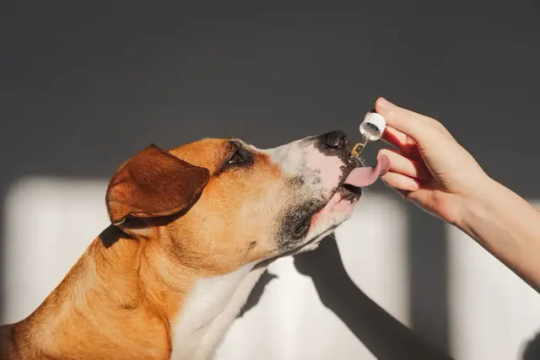
View On WordPress
0 notes
Text
0 notes
Text
Essential Dog First Aid Tips for Pet Owners
Knowing basic first aid for dogs is crucial for pet owners. While it’s not a substitute for veterinary care, having some knowledge and being prepared can save your pet’s life in an emergency. Make sure you have a well-stocked dog first aid kit at home and when traveling. Keep the phone numbers of your veterinarian and a 24-hour emergency veterinary hospital handy. Key Takeaways: Being prepared…
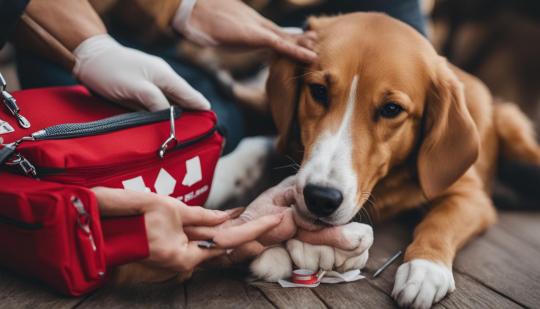
View On WordPress
#animal welfare#basic medical care#canine health#dog care#emergency preparedness#first aid#pet health#pet ownership#pet safety#veterinary care
0 notes